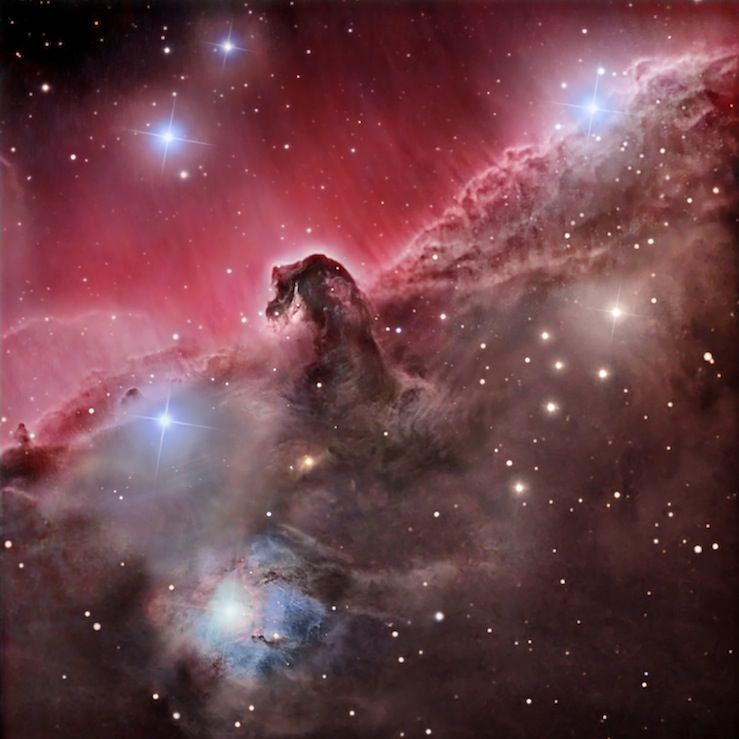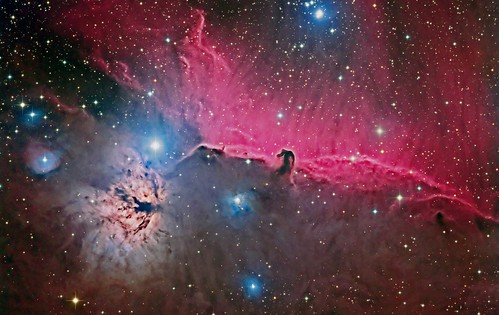I think the Orion Nebula region can help us understand a bit more about the role that stars and dust play for star formation.
The Horsehead Nebula.
Photo: Marco Burali, Tiziano Capecchi, Marco Mancini
The best-known of all dust pillars in the sky is probably the Horsehead Nebula in Orion. We don't usually think of it as the same kind of pillar as the
Pillars of Creation in the Eagle Nebula, but that is what it is.
The visible light image at left is actually a portrait of the evaporation (or, if you prefer it that way, the sublimation) of gas and dust in this high-energy environment. The Horsehead region is dominated by the harsh ultraviolet radiation from nearby hot stars. Note how red filaments of ionized hydrogen are rising like red smoke from the "wall" of dust running diagonally behind the Horsehead. What we are seeing is the wall eroding away, but the Horsehead, which is a part of this extended dust feature, still stands relatively tall, because it is the densest part of the upper layer of this wall of dust.
Note how the top of the Horsehead Nebula seems to emit white light. That is because all sorts of chemical reactions are taking place here, as the Horsehead meets the onslaught of ultraviolet light from O-type star Sigma Orionis, which is outside of the frame at top left in this picture.
Closeup of the tallest "Pillar of Creation". Photo:
NASA, ESA, and the Hubble Heritage Team
But are pillars like the Horsehead and the Pillars of Creation efficient star formation factories?
I would say no, particularly when it comes to the formation of massive stars. That is precisely because these pillars are evaporating away. The formation of massive stars requires massive, cold cores, and they are not to be had in a pillar being battered this way and that by fierce stellar winds and ultraviolet light.
Visible and infrared composite of the Horsehead region.
ESO/J. Emerson/VISTA. Acknowledgment: Cambridge Astronomical Survey Unit.
Composite Assembly and Processing: Robert Gendler.
But take a look at the visible and infrared composite image of the Horsehead Nebula region at left. The Horsehead itself is at upper right, and you can just make out a small star being born at the top of its head.
At lower left of the Horsehead is a bright nebula with a star inside. The nebula is reflection nebula NGC 2023, and the star is HD 37903, a newborn early B-type star, far more massive than the puny thing being born at the top of the Horsehead Nebula. NGC 2023 is deeper down in the dust and far more protected from the immediate onslaught of stellar wind and radiation than the Horsehead. So could the birth of massive HD 37903 actually have been facilitated by the hot stars in the region? I think that is a definite possibility. The cold core that became HD 37903 might well have been compressed and extra massive because of the "push" that was exerted on it by relatively nearby massive stars.
Horsehead and Flame Nebula region.
Photo: Terry Hancock.
Finally, take a look at the image at right of the Horsehead and Flame Nebula region. You can see the Horsehead, and just to the lower left of it, the rather small blue NGC 2023 reflection nebula. But farther to the left is a much more impressive, large, yellow nebula crisscrossed by dark dust lanes: the Flame Nebula. Clearly a lot more star formation is going on here than anywhere else in the Horsehead Nebula region.
What causes this bonanza of star formation? I'm going to have a guess. Almost immediately above the Flame Nebula is a blue star. The picture doesn't give this star justice, since it is suppressing the brightness of the star in order to bring out details in the nebula. The star is actually Alnitak, one of the brilliant stars of Orion's Belt. According to
Jim Kaler, Alnitak is some 20 times more massive than the Sun and 100,000 times more luminous, most of its energy radiated as ultraviolet light.
Alnitak is an incredibly powerful star, and I think it has a huge impact on the Flame Nebula. But it doesn't seem to be evaporating the Flame Nebula. The nebula seems to be mostly in front of the brilliant star, probably protected by an intervening wall of dust, but it is almost certainly somewhat compressed by the fierce stellar winds from the star.
So massive hot stars can both impede and facilitate star formation, by either evaporating or compressing dust.
Ann
 NGC 7822 in Cepheus
NGC 7822 in Cepheus

